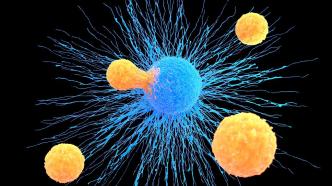

How to put a person on an interstellar journey into hibernation and "pause" physiological activities to span great distances and long periods of time?
A paper published online in the international academic journal "Nature Metabolism" (Nature Metabolism) on May 25 local time provides a new possible solution: it is believed to have found a key that can induce Animals enter a state similar to hibernation.
Experiments show that pulses of ultrasound can induce a reversible hibernation-like state in mice and rats, according to the paper.
The title of the paper is "Induction of a torpor-like hypothermic and hypometabolic state in rodents by ultrasound".
Hong Chen, an associate professor in the Department of Biomedical Engineering at Washington University in St. Louis, is the corresponding author of the paper.
Torpor is a hibernation-like physiological state, also known as a hypometabolic state, in which mammals inhibit metabolism, lower body temperature, and slow down other physiological processes to conserve energy.
Researchers have been exploring how mammals enter a state of "hibernation" for decades, but the control mechanisms that regulate entry into this state have only recently been revealed. The researchers found that the preoptic area (POA) of the hypothalamus plays an important regulatory role in the induction of dormancy.
Since the 1960s, the scientific community has been pursuing the noninvasive and safe induction of a torpor-like state. In the past, considerable effort has been devoted to identifying drugs that systemically inhibit metabolism and induce a torpor-like state. Previously, some scholars have used injections to make mice enter a hibernation-like state. Compared with other nonpharmacological and nongenetic neuromodulation techniques (e.g., deep brain stimulation, transcranial magnetic stimulation, and transcranial direct current stimulation), ultrasound stimulation has the unique ability to noninvasively Reach deep brain regions in both animal and human brains.
In the aforementioned newly published paper, the researchers designed an ultrasound transmitter, mounted on the head of a freely moving mouse, to emit ultrasound to the preoptic area of the hypothalamus of the freely moving mouse.
In addition, the authors designed an automatic closed-loop feedback controller to monitor core body temperature data to emit ultrasound pulses as needed.
During the experiments, the mice had free access to food and water. The experimental results showed that under the stimulation of ultrasonic pulses, the body temperature of the mice dropped immediately, accompanied by a drop in heart rate and oxygen consumption, but they recovered completely within 2 hours. The authors then combined ultrasonic transmitters and an automatic closed-loop feedback controller to repeatedly emit ultrasonic pulses when body temperature began to rise, thereby maintaining this type of hibernation in experimental animals for up to 24 hours, and the experimental animals showed no signs of injury or discomfort.
The study found that the technique worked on 12 rats. Rats are generally not considered to hibernate naturally, although their body temperature only drops by 1-2°C. According to the researchers, this suggests that this physiological process that regulates metabolic responses may also exist in non-hibernating mammals.
So, is this method applicable to humans themselves?
In the animal kingdom, there are not many animals that can naturally enter a state similar to hibernation, especially primates. In past studies, humans have found that fat-tailed pygmy lemurs can naturally go into hibernation in order to overcome the lack of food during the tropical dry season. Therefore, other primates (including humans) may in principle have the genetic makeup to deal with a hypometabolic state.
Can larger mammals go into hibernation like lemurs?
Previous studies have found that in winter, bears also experience hypometabolism, with a basal metabolic rate drop of up to 75%, but it has little effect on body temperature. Thus, prolonged hypometabolic states are possible even in mammals larger than humans.
A related review article published in "Nature" stated that the above-mentioned newly published innovative research paves the way for non-invasive induction of dormancy. This is a huge step forward in harnessing hibernation-like states and future deep space travel."
But how to wake up from the deep torpor and restart the metabolism, the regulation mechanism and method of this process are still completely unknown.
